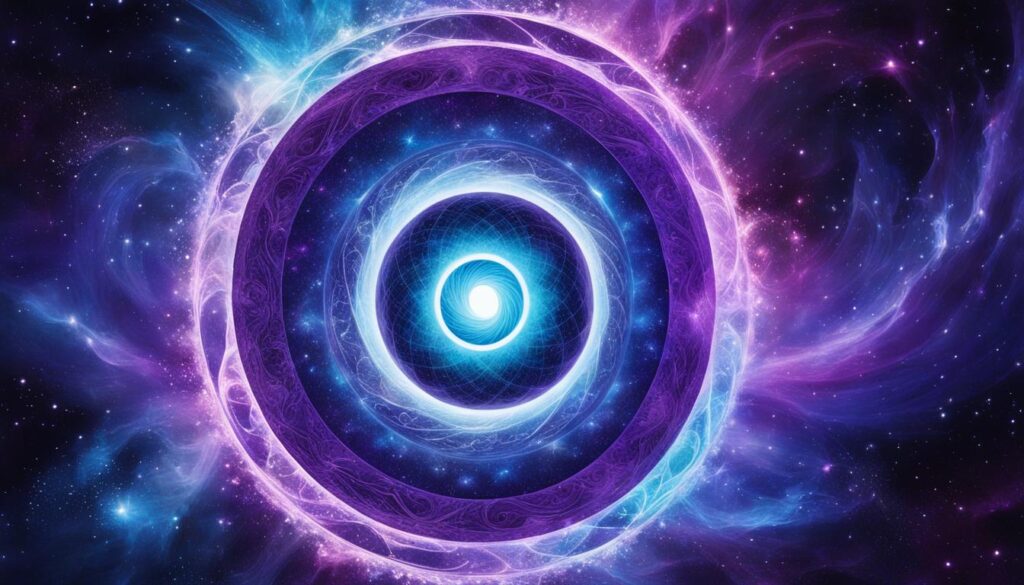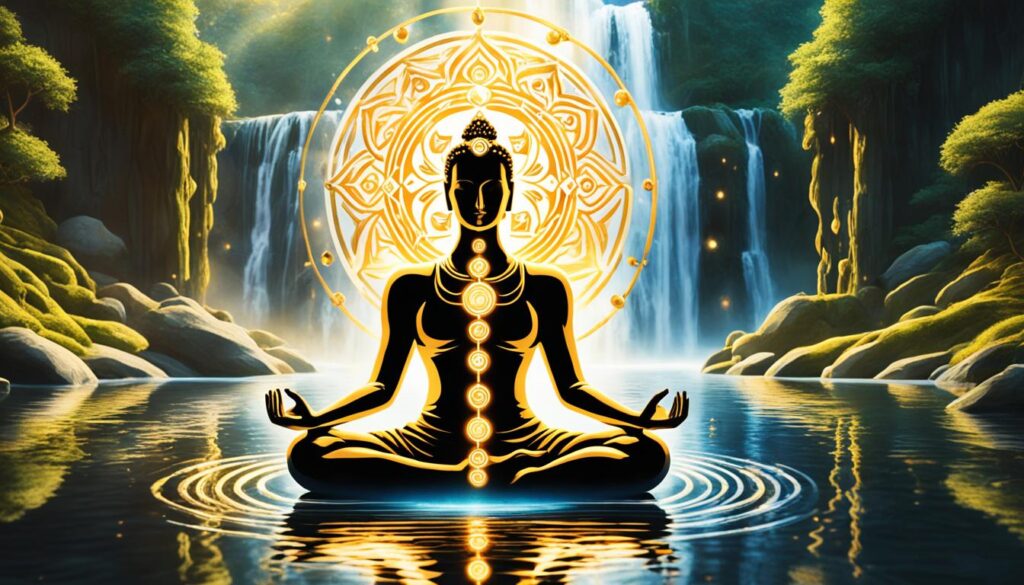Have you ever wondered about the deeper meaning behind the karma symbol? What is its significance in spirituality, and how can it help us understand the concept of karma? Dive into the world of symbolism and explore how the karma symbol can unlock profound insights and empower personal growth.
Key Takeaways:
- Understanding the karma symbol can provide insights into our interconnectedness with the world and the consequences of our actions.
- Karma is the universal law of cause and effect, emphasizing the importance of acting ethically and mindfully.
- The karma symbol appears in various spiritual traditions, each with its unique interpretation and representation.
- The origins of the karma symbol can be traced back to ancient India, where concepts of karma originated.
- Karmic symbols can be harnessed for healing and incorporated into daily practices such as meditation and yoga.
The Meaning and Significance of Karma
Karma is the universal law of cause and effect, emphasizing that our actions and intentions create a ripple effect that determines our present circumstances and future experiences. The karma symbol symbolizes this interconnectedness and the cyclical nature of karma. It reminds us of the need to act ethically, with compassion and mindfulness, to create positive outcomes for ourselves and others.
In spirituality, the karma symbol holds deep meaning and significance. It represents the fundamental principle that our actions have consequences, both in this life and beyond. By understanding and embodying the teachings of karma, we can shape our destiny and nurture personal growth.
The karma symbol is often depicted as a wheel with eight or twelve spokes, representing the Eightfold Path or the Twelve Laws of Karma in Buddhism. This symbolic wheel serves as a visual reminder of the interconnectedness between our thoughts, actions, and outcomes. It encourages us to reflect on our choices and encourages us to align our intentions with positive karma.
When we integrate the karma symbol into our spiritual practices, we cultivate a deeper understanding of our actions’ ripple effects and our interconnectedness with the world. It serves as a potent symbol that guides us towards ethical behavior, compassion, and mindfulness.

| Meaning of Karma Symbol | Karma Symbol Significance | Karma Symbol in Spirituality |
|---|---|---|
| Represents the universal law of cause and effect | Reminds us of the interconnectedness of our actions and their consequences | Guides us towards ethical behavior, compassion, and mindfulness |
| Symbolizes the cyclical nature of karma | Encourages us to reflect on our choices | Cultivates a deeper understanding of our interconnectedness with the world |
| Emphasizes the need to act ethically | Encourages alignment of intentions with positive karma | Nurtures personal growth and spiritual development |
Exploring the Karma Symbol in Different Spiritual Traditions
The karma symbol holds profound meanings within various spiritual traditions, each interpreting and representing it in unique ways. Let’s delve into the interpretations, representations, and designs of the karma symbol in Buddhism and Hinduism.
Buddhism:
In Buddhism, the karma symbol is often depicted as a wheel with either eight or twelve spokes. This symbolizes the Eightfold Path or the Twelve Laws of Karma, which serve as guidelines for leading a virtuous and mindful life. The wheel represents the continuous cycle of birth, death, and rebirth, emphasizing the interconnectedness of actions and their consequences.
Hinduism:
In Hinduism, the karma symbol takes the form of intertwined snakes or a circular pattern with arrows. These designs symbolize the intricate interplay between actions, intentions, and their consequences. They highlight the belief in karma’s far-reaching impact, spanning across multiple lifetimes.
Both interpretations of the karma symbol serve as powerful reminders of our actions’ enduring effects and the importance of living in harmony with the natural laws that govern the universe.
The Origin and Evolution of the Karma Symbol
The exact origin of the karma symbol is difficult to trace, as it has been in use for centuries across different cultures. However, it is believed to have originated in ancient India, where concepts of karma first emerged. Over time, the symbol has evolved and taken on various forms in different spiritual traditions, reflecting cultural influences and interpretations.
In ancient India, the karma symbol was deeply rooted in the teachings of Hinduism and Buddhism. It served as a visual representation of the interconnectedness between actions and consequences. The karma symbol was a reminder that every action we take, whether big or small, has reverberating effects on ourselves and the world around us.

In Hinduism, the karma symbol, sometimes depicted as intertwined snakes, represents the cycle of birth, death, and rebirth. It signifies the continuous journey of the soul through different lifetimes, and the consequences of one’s actions in each life. The intricate design of the karma symbol in Hinduism reflects the complexity and intricacy of the cosmic order.
In Buddhism, the karma symbol is often represented as a wheel with eight or twelve spokes. This symbolizes the Eightfold Path or the Twelve Laws of Karma, which guide individuals on how to live a virtuous life and break free from the cycle of suffering. The circular shape of the karma symbol in Buddhism represents the endless cycle of cause and effect.
As the karma symbol spread beyond its origins in India, it underwent further adaptations and interpretations in different cultures. Today, we can see variations of the karma symbol in various forms of art, jewelry, and tattoos. Each interpretation reflects the unique cultural perspectives and beliefs of different societies.
| Symbol | Religion/Tradition | Representation |
|---|---|---|
| Interconnected Snakes | Hinduism | Symbolizes the cycle of birth, death, and rebirth; interconnectedness of actions and consequences |
| Wheel | Buddhism | Represents the Eightfold Path or the Twelve Laws of Karma; cyclical nature of cause and effect |
Harnessing the Power of Karmic Symbols for Healing
Karmic symbols hold immense potential for healing emotional wounds and addressing past traumas. By incorporating symbols such as the cho ku rei, sei hei ki, hon sha ze sho nen, and Yin and Yang into your life, you can tap into their transformative energies and embark on a profound journey of self-healing and personal growth.
These karmic symbols serve as tools to channel energies, find clarity, and restore emotional balance. Through meditation and contemplation, you can deepen your connection with these symbols and harness their healing power. By opening yourself up to their wisdom, you can nurture emotional wounds, release negative energies, and bring harmony to your mind, body, and spirit.
Karmic Symbols for Emotional Healing
Each karmic symbol has its unique qualities and can address specific emotional needs. Understanding the symbolism behind these powerful symbols can help guide your healing journey:
- The cho ku rei symbolizes the flow of divine energy and can be used to bring healing to emotional pain and trauma.
- The sei hei ki symbolizes mental and emotional healing, promoting emotional balance and helping to release negative emotions.
- The hon sha ze sho nen symbol represents distance healing and can be used to heal emotional wounds from the past, even across lifetimes.
- The Yin and Yang symbol epitomizes the idea of balancing opposing forces and can be used to restore emotional harmony and create a sense of wholeness.
By exploring these karmic symbols and understanding their individual meanings, you can tailor your practice to address specific emotional healing needs. Incorporating these symbols into your meditation, visualization, or energy healing practices can enhance their effectiveness and bring about profound emotional transformation.

Visual representation of karmic symbols carries its own magnetic power. As you explore the healing potential of these symbols, allow yourself to connect with their visual representation. The image above showcases the vibrancy and interconnectedness of these symbols, reflecting their capacity to facilitate emotional healing and spiritual growth.
Applying Karmic Symbols in Daily Life
Integrating karmic symbols into your daily routines can deepen your understanding of karma and enrich your spiritual journey. By incorporating these symbols into practices such as meditation and yoga, you can tap into their transformative power and align your mind, body, and spirit.
Meditation with Karmic Symbols
Meditation is a powerful tool for self-reflection and mindfulness. When combined with karmic symbols, it can help you delve deeper into the concept of karma and its impact on your life. Find a quiet space where you can sit comfortably, close your eyes, and focus your attention on the symbol that resonates with you.
Visualize the symbol in your mind’s eye as you breathe deeply, allowing its energy to flow through your being. Reflect on your actions and intentions, considering the karmic consequences they may have. Use the symbol as a focal point to bring clarity and awareness to your thoughts, emotions, and patterns of behavior.
Through regular meditation with karmic symbols, you can develop a heightened sense of self-awareness, compassion, and gratitude. This practice can help you cultivate positive intentions and make conscious choices that align with your values, leading to a more harmonious and fulfilling life.
Yoga with Karmic Symbols
Yoga is a holistic practice that combines physical postures, breathwork, and meditation to promote balance and harmony in the body and mind. By incorporating karmic symbols into your yoga practice, you can amplify its transformative effects and deepen your connection to the concept of karma.
Choose a symbol that resonates with you and place it in a prominent position in your yoga space. As you move through your yoga flow, focus your attention on the symbol, allowing its energy to infuse your movements and intentions. Connect with your breath, syncing it with each pose and transition, and visualize the symbol’s significance in your practice.
Yoga with karmic symbols can help you align your physical and emotional energies, facilitate healing and release, and invite personal transformation. As you flow through each posture, reflect on the interconnectedness of your actions and the ripple effects they create, both on and off the mat.
By incorporating karmic symbols into your daily meditation and yoga practices, you can deepen your understanding of karma, cultivate mindfulness, and embark on a journey of self-discovery and growth.

| Benefits of using Karmic Symbols in Daily Life | How to incorporate Karmic Symbols |
|---|---|
| 1. Deepens understanding of karma | 1. Find a quiet space for meditation |
| 2. Enhances spiritual journey | 2. Choose a karmic symbol that resonates with you |
| 3. Cultivates mindfulness and self-awareness | 3. Visualize and reflect on the symbol’s meaning |
| 4. Facilitates healing and personal transformation | 4. Incorporate the symbol into yoga poses and transitions |
| 5. Promotes harmony and balance in daily life | 5. Sync your breath with the symbol’s energy |
By embracing karmic symbols in your daily life, you can infuse your actions with intention, aligning yourself with the universal laws of karma and inviting positive change into your journey.
Conclusion
The karma symbol is a powerful representation of the interconnectedness of our actions and their consequences. By embracing the symbolism and teachings associated with this ancient symbol, you can tap into the profound power of karma in your life and strive towards personal and societal harmony. It serves as a constant reminder that every action we take has a ripple effect that extends far beyond what we can perceive.
Through ethical actions, compassion, and the integration of karmic symbols into your daily practices, you can transform your perspective and promote healing on a deep level. Recognizing the impact of your actions and intentions allows you to navigate life’s challenges with wisdom and grace, fostering personal growth and positive change.
Take a moment to reflect on the power of the karma symbol and its profound takeaway. By aligning your actions with the principles it represents, you can create a positive ripple that not only benefits your life but also contributes to a more harmonious and interconnected world. Embrace the wisdom of karma, and let its guiding principles shape your journey towards a more fulfilling and enlightened existence.
FAQ
What is the meaning of the karma symbol?
The karma symbol represents the concept of karma, which is the belief that a person’s actions and intentions have consequences that shape their present life and future incarnations.
What is the significance of the karma symbol in spirituality?
The karma symbol serves as a reminder of the interconnectedness of our actions and their consequences, emphasizing the need to act ethically and create positive outcomes for ourselves and others.
How is the karma symbol interpreted and represented in different spiritual traditions?
In Buddhism, the karma symbol is often depicted as a wheel with eight or twelve spokes, representing the Eightfold Path or the Twelve Laws of Karma. In Hinduism, it takes the form of intertwined snakes or a circular pattern with arrows, symbolizing the interconnectedness of actions and their consequences.
What is the origin of the karma symbol?
The exact origin of the karma symbol is difficult to trace, but it is believed to have originated in ancient India, where concepts of karma first emerged. Over time, it has evolved and taken on various forms in different cultures.
How can karmic symbols be used for healing?
Karmic symbols such as the cho ku rei, sei hei ki, hon sha ze sho nen, and Yin and Yang can be used for healing emotional wounds and addressing past traumas. They serve as tools to channel energies, promote emotional balance, and facilitate self-healing and personal growth.
How can karmic symbols be applied in daily life?
Karmic symbols can be integrated into daily practices such as meditation and yoga to deepen our understanding of karma and enhance our spiritual journey. Through meditation, we can reflect on our actions and cultivate mindfulness. Practicing yoga with karmic symbols can help align physical and emotional energies, promoting karmic healing and personal transformation.
What is the takeaway from the karma symbol?
By embracing the symbolism and teachings associated with the karma symbol, we can unlock the power of karma in our lives and work towards personal and societal harmony. Acting ethically, cultivating compassion, and integrating karmic symbols into our daily practices can bring wisdom, grace, and positive transformation.

